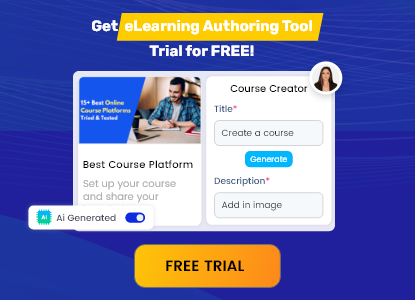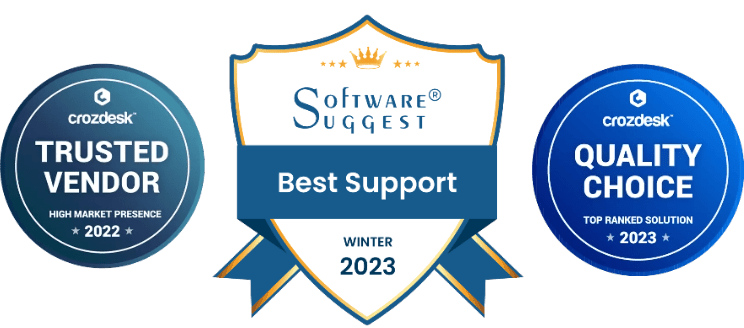The eLearning landscape is continuously evolving, and so are the tools used to create digital learning experiences. As educational institutions and corporate training environments shift toward online and remote learning, eLearning authoring tools trends are emerging to address new challenges and opportunities. In this blog, we explore the top trends in the eLearning authoring tools market, including immersive learning, mobile-friendly content, collaborative features, accessibility, personalization, gamification, and seamless integration with Learning Management Systems (LMS).
Trends In the eLearning Authoring Tools: An Overview
- Increasing Adoption of Online Learning: The rapid shift toward remote education and corporate training is boosting the demand for innovative authoring tools.
- Advancements in Technology: Incorporating Artificial Intelligence (AI), Virtual Reality (VR), Augmented Reality (AR), and gamification elements has revolutionized user engagement.
- Cost-Effective Training Solutions: Educational institutions and businesses are increasingly adopting these tools as a scalable and affordable alternative to traditional training methods.
Trends In the eLearning Authoring Tools: Detailed Analysis
Rise of Immersive Learning Experiences
One of the most significant trends in the eLearning authoring tools market is the incorporation of immersive learning experiences. By leveraging AR and VR, educators can simulate real-world environments that offer hands-on, experiential learning. Immersive experiences not only enhance engagement but also improve knowledge retention by allowing learners to interact with the content in a multi-dimensional space.
Mobile-Friendly Content Creation
As mobile devices become the primary means of accessing digital content, the demand for mobile-friendly learning environments has surged. eLearning authoring tools trends now emphasize the creation of responsive content that adapts seamlessly across smartphones, tablets, and laptops. This shift ensures that learners can access educational resources on the go, without compromising on the quality or interactivity of the learning experience.
Mobile-friendly content creation means designing interfaces and interactions that are intuitive and accessible on smaller screens. This approach not only broadens the reach of educational content but also aligns with the modern learner’s lifestyle, where flexibility and convenience are paramount.
Collaborative Authoring and Sharing
The era of isolated content creation is over. Today’s educational environments thrive on collaboration, and eLearning authoring tools are no exception. Modern tools now offer real-time editing, co-authoring capabilities, and easy content sharing, allowing teams of educators and instructional designers to work together efficiently. This trend in collaborative authoring facilitates a more iterative and creative process, leading to more refined and impactful learning modules.
Collaboration in content creation fosters innovation by combining diverse perspectives and expertise. For example, a team might include subject matter experts, graphic designers, and technical specialists who collaboratively develop a course module. This collaborative approach not only speeds up the development process but also ensures that the final product is robust and well-rounded.
Accessibility and Inclusivity
Data-Driven Personalization
Gamification and Interactive Elements
Gamification is revolutionizing the eLearning landscape by introducing game-based elements such as points, badges, leaderboards, and interactive simulations into educational content. By transforming learning into an interactive and often competitive experience, gamification increases learner engagement and motivation.
Interactive elements, such as quizzes, simulations, and branching scenarios, make learning fun and impactful. When learners engage with content in a playful yet challenging manner, they are more likely to retain information and apply what they have learned. This trend in gamification is a direct response to the need for more engaging and effective learning strategies in both academic and corporate settings.
Integration with Learning Management Systems (LMS)
Seamless integration with Learning Management Systems (LMS) is one of the most practical and transformative trends in the eLearning authoring tools market. By ensuring that content created with authoring tools can be easily uploaded, managed, and tracked within an LMS, educators and training managers can streamline the entire learning process.
Trends In the eLearning Authoring Tools: The Future of Digital Learning
- Increased AI Integration: As artificial intelligence continues to develop, we may see more sophisticated AI-driven features in eLearning authoring tools, such as automated content adaptation, real-time learner feedback, and even virtual tutors.
- Enhanced Interoperability: The integration between various educational technologies is likely to become more seamless, ensuring that content flows effortlessly between different systems and platforms.
- Focus on Microlearning: With the growing demand for bite-sized learning experiences, authoring tools will likely incorporate features that support the creation of microlearning modules, which can be consumed quickly and efficiently.
- Global Collaboration: As remote learning becomes more prevalent, the need for collaborative tools that bridge geographical gaps will increase. Future authoring tools may offer more robust solutions for global teamwork, enabling educators from different parts of the world to co-create content effortlessly.























